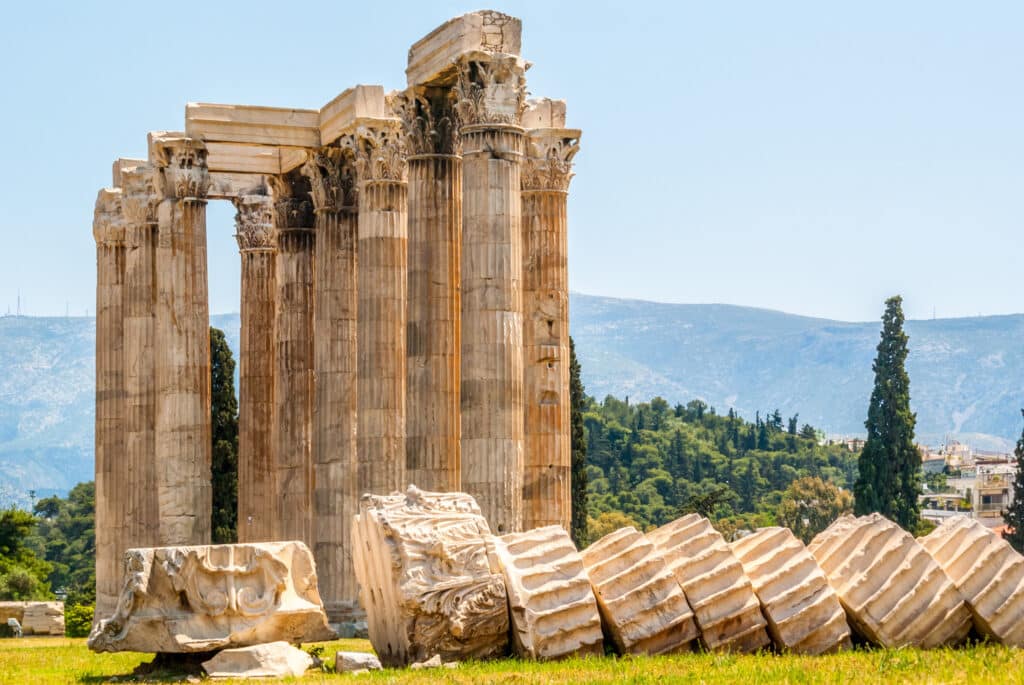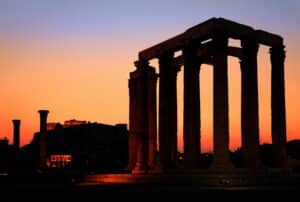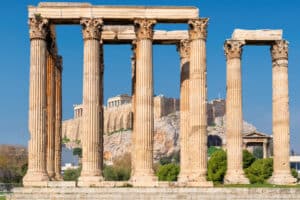
The entrance fee for the Temple of Olympian Zeus is 6€ for 2025. Children under 5, EU citizens under 25 and students get in free, no need to buy an Temple of Olympian Zeus ticket.
Temple of Olympian Zeus tickets are sold at the entrance gate. However, especially during the tourist season, you can buy your ticket online in advance to avoid waiting in long ticket queues and to enter the Temple of Olympian Zeus quickly. If you buy your Temple of Olympian Zeus ticket online, you do not need to print out your ticket, and the ticket sent to your mobile phone will be enough to enter the Temple of Olympian Zeus. You can book a fast-track ticket for the Temple of Olympian Zeus in advance, you can also join guided tours or take a look at the combined ticket options.
A temple to the supreme god of the Greek pantheon Zeus, who had previously been worshipped in the open air, was built by Peisistratos on this site at some time before 550 BC – a hundred years before the erection of the temple of Zeus at Olympia. It was rather smaller than the later Parthenon (see Acropolis). The site, to the south-east of the Acropolis, then lay outside the city.
Historical Background of the Temple of Olympian Zeus
Peisistratos’ sons Hippias and Hipparchos resolved to replace this temple by a gigantic new structure with a double colonnade (dipteros), comparable with the temple of Hera built by Polykrates on the island of Samos.

The Temple of Olympian Zeus after sunset, with Acropolis in the background.
Work on this building was suspended after the expulsion of Hippias in 510 BC, and it lay unfinished until about 175 BC, when the Syrian king Antiochos IV commissioned a Roman architect, Cossutius, to complete it. The new temple was designed to have a double colonnade of Corinthian columns, some 17 m high, of Pentelic marble; but this temple, too, remained unfinished, and it was not completed for another 300 years, until about ad 130, when Hadrian had it finished in accordance with Cossutius’ plan. Its construction had thus taken altogether 650 years.
Because it is a symbol of the time when Athens was oppressed by a Syrian king and a Roman emperor, the Temple of the Olympian Zeus – the largest temple in Greece – has always been something of a thorn in the flesh of the people of Attica. The Olympieion is still overshadowed by the Acropolis, although the quality of its construction deserves of more attention.

Olympian Zeus temple and the Acropolis in Athens
The cella, which contained a statue of Hadrian as well as the cult image of Zeus, has disappeared, as have most of the 104 columns, the making of which used some 15,500 metric tons of marble. The remains, however – a group of 13 columns and part of the entablature at the south-east corner, two isolated columns on the south side, and another column that collapsed in 1852 – still retain something of their original grandeur. It is not certain whether the 13 south-east columns belong to the Hellenistic building and the three on the south side to the Roman one, or whether they are all of Roman date.
The entrance to the site is in Leoforos Olgas. Near the entrance in the old defensive ditch of Athens, are a number of column drums from the Peisistratid temple. Further west are the remains of Roman baths and other buildings. Through the partly reconstructed propylon we enter the large rectangular temenos in which the temple lies.
From the south wall of the temenos we can look down into an excavated area on a lower level in which, among other structures, the foundations of the temple of Apollo Delphinios and the large rectangle of the Penhellenion can be distinguished. They are among the many temples and shrines on the banks of the llissos, which flows underground through this area; others include the temple of Aphrodite in the gardens on the right bank of the stream, the Metroon and the shrine of Artemis Agrotera on the left bank.
In Christian times a basilica was built here by the ancient Kallirhoe spring; mosaics are in the Byzantine Museum. A footpath leads along the eastern external wall of the Olympieion.

